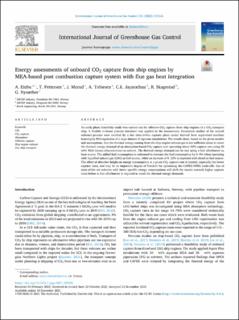| dc.contributor.author | Einbu, Aslak | |
| dc.contributor.author | Pettersen, Torbjørn | |
| dc.contributor.author | Morud, John | |
| dc.contributor.author | Tobiesen, Finn Andrew | |
| dc.contributor.author | Jayarathna, Chameera | |
| dc.contributor.author | Skagestad, Ragnhild | |
| dc.contributor.author | Nysæther, Gisle | |
| dc.date.accessioned | 2022-06-10T13:29:19Z | |
| dc.date.available | 2022-06-10T13:29:19Z | |
| dc.date.created | 2022-01-25T11:32:34Z | |
| dc.date.issued | 2022 | |
| dc.identifier.citation | International Journal of Greenhouse Gas Control. 2022, 113, 12. | en_US |
| dc.identifier.issn | 1750-5836 | |
| dc.identifier.uri | https://hdl.handle.net/11250/2998339 | |
| dc.description.abstract | An early phase feasibility study was carried out for offshore CO2 capture from ship engines of a CO2 transport ship. A flexible in-house process simulator was applied in the assessments. Parametric studies of the overall onboard process were enabled by a fast data-driven capture plant model derived from supervised machine learning by PLS regression of a large dataset of rigorous simulations. The results show, based on the given models and assumptions, that the thermal energy coming from the ship engine exhaust gas is not sufficient alone to cover the thermal energy demand of an absorption-based CO2 capture unit operating above 50% capture rate using 30 wt% MEA (mono-ethanolamine) as solvent. The thermal energy demand can be met using a fuel afterburner as heat source. The added fuel consumption is estimated to increase the fuel consumption by 6–9% when operating with liquefied natural gas (LNG) as fuel source, while an increase of 8–12% is expected with diesel as fuel source. The effect of absorber height on energy consumption at a given CO2 capture rate is limited, especially for lower capture rates, and may be an important degree of freedom for optimizing the CAPEX/OPEX trade-offs. Use of state-of-the art solvents with lower specific energy consumptions will shift the results towards higher capture rates before a fuel afterburner is required to meet the thermal energy demands. | en_US |
| dc.language.iso | eng | en_US |
| dc.publisher | Elsevier | en_US |
| dc.rights | Navngivelse 4.0 Internasjonal | * |
| dc.rights.uri | http://creativecommons.org/licenses/by/4.0/deed.no | * |
| dc.subject | CO2 ship transport | en_US |
| dc.subject | Ship engine exhaust | en_US |
| dc.subject | Offshore capture | en_US |
| dc.subject | Absorption | en_US |
| dc.subject | CO2 capture | en_US |
| dc.subject | CSS | en_US |
| dc.title | Energy assessments of onboard CO2 capture from ship engines by MEA-based post combustion capture system with flue gas heat integration | en_US |
| dc.title.alternative | Energy assessments of onboard CO2 capture from ship engines by MEA-based post combustion capture system with flue gas heat integration | en_US |
| dc.type | Peer reviewed | en_US |
| dc.type | Journal article | en_US |
| dc.description.version | publishedVersion | en_US |
| dc.rights.holder | © 2021 The Author(s). Published by Elsevier Ltd. | en_US |
| dc.source.pagenumber | 12 | en_US |
| dc.source.volume | 113 | en_US |
| dc.source.journal | International Journal of Greenhouse Gas Control | en_US |
| dc.identifier.doi | 10.1016/j.ijggc.2021.103526 | |
| dc.identifier.cristin | 1989331 | |
| dc.source.articlenumber | 103526 | en_US |
| cristin.ispublished | true | |
| cristin.fulltext | original | |
| cristin.qualitycode | 1 | |

